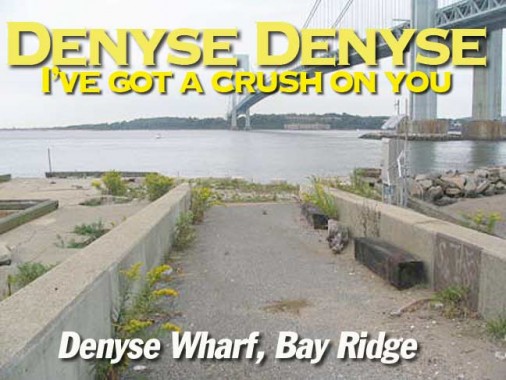Your webmaster has never met a Denise, or a Denyse, for that matter, who was unattractive. At the same time, Bay Ridge, Brooklyn’s Denyse Wharf, or its remains, are not much to look at. The wharf, however, is a lost treasure of the colonial past and a Revolutionary War remnant.
To arrive at the wharf, the only way is to walk or bike on the 4th Avenue overpass on the Belt Parkway at Shore Road. The path reaches a fork in the road — bear left down the hill to the shoreline bike path and walk forward, under the Verrazano-Narrows Bridge.
Denyse Wharf, 1964
You will soon encounter a concrete jetty leading to an outcropping of stones jutting into the Narrows.
As you can see at left, the wharf used to be a rather important pier. It used to have direct access to the Belt Parkway — you can still see the narrow road that connects the wharf and the Belt.
I had always thought that it was somehow busier in the past, and after researching it I discovered that it is actually a remnant of the Battle of Brooklyn in 1776.
Padlocked to keep out daredevils who may be tempted to swim the Narrows, Denyse Wharf is a true link to the Revolutionary War. In the colonial era, before there was a Fort Hamilton or a Belt Parkway, Bay Ridge was a part of the town of New Utrecht. Three of the town’s foremost citizens, Adrian Bennett, Simon Cortelyou, and Denyse Denyse, had homesteads right about here, and Denyse ran a ferry to Staten Island close to his home.
The British and their Hessian and Scottish compatriots under General William Howe chose the Denyse Ferry as the place to land in New Utrecht for a major offensive on August 22, 1776, after massing 437 ships off Sandy Hook by July 12th. The Narrows was relatively undefended since the Americans were expecting a landing at Gravesend. According to legend, a Tory (loyalist) woman waved a red petticoat from Cortelyou’s house to signal the invaders: many New Utrecht residents were loyalists. The patriots had only three cannons on the promontory above the Narrows, and fought vigorously, but the British warship Asia responded by firing a volley that damaged Bennett’s and Denyse’s houses, but curiously, not Cortelyou’s. 15,000 British troops entered New Utrecht virtually unscathed; they were quickly able to overrun Kings County, bivouacking in the various homesteads throughout the locale. Howe himself commandeered Cortelyou’s house. Denyse himself was a patriot. In 1783, when the British evacuated New York City, they left from the Denyse Ferry.
The peninsula in the distance, past the crumbling Denyse Wharf concrete jetty, is Coney Island. Look very carefully and you can barely make out the Parachute Jump toward the right. Dimly seen at the right of the picture is Staten Island. Photo right: are these original stones of Denyse Wharf?
The Cortelyou house stood until about 1894, when it was torn down to enlarge Fort Hamilton. The old ferry landing survived as a pier, becoming little-used especially after the Belt Parkway was built here in 1940, though a direct connection was built to the pier as mentioned previously. By the time I saw the ferry pier in the 1960s, it was a dilapidated T-shaped structure; at low tide, there were wrecked small vessels and discarded tires. A small remnant is still there; there’s talk of landmarking it as the spot where the British entered and left New York during the Revolution.
Beyond the wharf you can spot Hoffman and Swinburne Islands, which sit in the Narrows just east of Staten Island’s South Beach. Both are man-made islands (with dredged sand) that were formerly used to quarantine immigrants with contagious diseases.
This is likely Swinburne, since Hoffman is the more southerly of the two.
Marie Lorenz, who investigated the Yellow Submarine of Coney Island Creek, and Rachel Mason rowed out to Hoffman Island, and even braved the Narrows for a swim (not recommended, as the currents may take you where you don’t want to go).
SOURCES:
Bay Ridge Chronicles, Jerome Hoffman, Bay Ridge Historical Society 1976
Bay Ridge and Fort Hamilton, a Photographic Journey, Brian Merlis, Brooklyn Editions 2000
10/8/08




